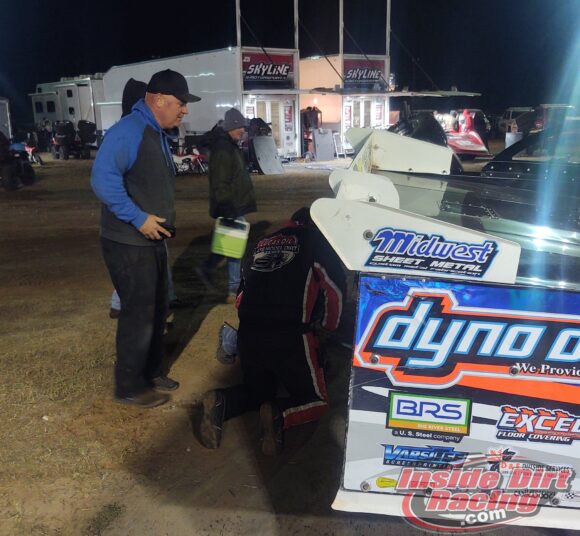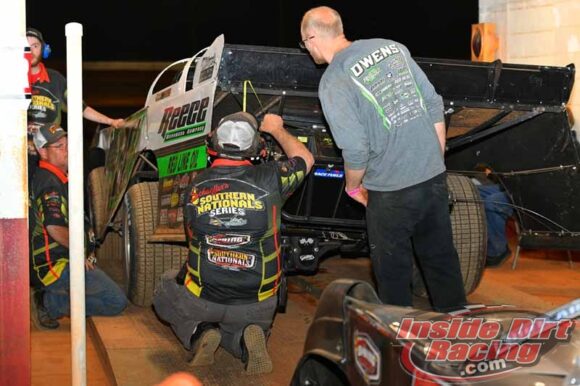
SSI Motorsports crew chief Anthony Burroughs looks on as the “Droop” is checked on the car of Ricky Thornton Jr. at Golden Isles Speedway
The talk of the Dirt Late Model world from this past weekend is largely about one thing – the droop rule. And rightly so considering that a car’s failure to meet the specifications of that stipulation caused the disqualification of a race winner. And it wasn’t just any race that was lost, it was the $50,000-to-win crown jewel Show-me 100 at the Lucas Oil Speedway in Wheatland, Missouri.
Ricky Thornton Jr. took the checkered flag ahead of the pack in that event and appeared to be the victor in the Lucas Oil Late Model Dirt Series-sanctioned feature. However, after a longer-than-usual amount of time spent at the tech inspection area, it was announced that the SSI Motorsports No. 20RT had failed the droop check and the apparent win had been disallowed(given a four-place penalty dropping him to 5th in the final rundown). Instead, Double Down Motorsports driver Devin Moran was pronounced the winner.
The droop rule was first instituted in 2018 by Schaeffer’s Oil Southern Nationals promoter Ray Cook. It was stated at that time that a chain would connect the car’s rear end to a frame rail for the purpose of limiting vertical movement at the left rear of the machine. It was said that doing so would help to reduce roll over crashes.
To measure the droop, an official will jack the rear end of the car up until the left rear tire comes off the ground. A flat pan looking like something that would be used to remove a pizza from an oven is slid under the left rear tire to confirm that it is off the ground. Once that has happened, an official will measure from a specified point on the rear deck lid to the ground. According to the DIRTcar Rule Book, that measurement is not to exceed 50.5 inches.
The droop rule has been the subject of much scorn from competitors and fans alike since its inception. Every time there is a high profile disqualification of a race winner or even a qualifying time, the bitterness refires. Of course, that was the case on Saturday night/Sunday morning when Thornton’s penalty became known.
For the moment, it is the rule to hate.
When I first started covering dirt racing back in 2008, I quickly learned the lesson of not writing a post-race story until the winner’s tires had been checked in the tech area. Back then, the infraction most looked for was tampering with tires by adding some unapproved substance to them. Fans and competitors often called those disqualifications unnecessary or unfair in the same way they are deriding the droop rule. The history of all racing has been one of teams trying to find a competitive edge then once officials have figured that trick out they move to another.
In a few years, it will be something else.
I am not a mechanical person and have never claimed to be so I have no idea whether or not a violation of the droop specifications provides a competitive edge or not. Further, there is really no way of knowing whether or not the limitation of vertical travel in the left rear of the car has had a significant impact on the number of roll over crashes or not. But the fact of the matter is that, until those who make the rules decide to make a change, it is the rule. And as such, the car must be in compliance.
Some pointed out that the track at Lucas Oil Speedway was rough on Saturday night and that may have contributed to a parts failure bringing about the post-race failure. Perhaps some leeway, they said, should be given to account for that. Such cannot be the case because the people who work on these cars have some of the smartest and most innovative minds in any industry. If leeway is to be given, they will find a way to take advantage of that which would render any rule, droop or otherwise, useless.
Whether you like it or not, the rule is the rule. What it says it what it has to mean in the same way rules regarding engines, car weight, body configurations, or anything have to be enforced.
Dirt racing enthusiasts can debate the need for the rule as much as they want, but as long as it is the rule, it is the rule. As stated above, I am not going to get into that debate because I don’t have the knowledge to do so. That is for those more equipped in that discussion than me.
Please consider watching:
Respond to this post on Twitter by following @RichardAllenIDR and @MichaelRMoats or by liking the InsideDirtRacing.com Facebook page.
Also, NASCAR and pavement racing fans can check out InsideCircleTrack.com






